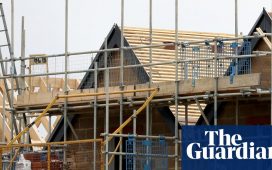The disastrous, unjust consequences of Britain’s dysfunctional housing market, which has been decades in the making, are all too familiar. Rampant house-price inflation and nimbyism have placed the property ladder beyond the reach of millions of young people. Private rents have soared, eroding living standards and fuelling homelessness.
Misconceived right-to-buy schemes have driven up demand but not supply. The stock of social housing has scandalously diminished at a rate that cash-strapped local authorities cannot keep up with. Repeatedly, governments have pledged to address a shortage of homes now estimated at 4m. Repeatedly, they have miserably failed to do so.
Announcing a draft new National Planning Policy Framework (NPPF) to the Commons, Angela Rayner, the deputy prime minister and secretary of state for housing, described this dismal state of affairs as “the most acute housing crisis in living history”. To address it, Labour has pledged to build 370,000 homes a year during the course of the next parliament – an exponential improvement on the record of the last one. Amid industry scepticism that this can be done so quickly, the fast-track planning consultation Ms Rayner launched on Tuesday was a spiky declaration of intent.
The direction of travel she outlined has much to recommend it. The restoration of mandatory local housebuilding targets – cravenly removed by Rishi Sunak as he attempted to placate a nimby-led backbench rebellion – is the welcome centrepiece to Labour’s plan. History has shown that without such intervention, necessary building does not get done. Two-thirds of local councils do not currently have an up-to-date plan addressing the need for new homes, and too many have shown themselves resistant to coming up with one. A national mission, which is how fixing the housing crisis should be viewed, requires a nationwide response.
There will be trouble ahead, as areas object to what Ms Rayner acknowledged will be in some cases “surprising” targets. But the government is right to declare itself ready for the battles to come, which will be one of the political dividing lines of this parliament. In other respects, the plans also hit the right notes. The move to redesignate areas of wasteland on the edge of towns as “grey” rather than green belt, for example, is a smart way to address a perennial problem. Defending pastoral England from urban sprawl is one thing; protecting disused car parks and former petrol stations quite another.
In other areas, Labour will need to invest more, and go further, if its ambitious targets are to be met. From equipping councils with a sufficient number of planners, to ensuring a supply of skilled construction workers, restoring hollowed-out capacity after the years of neglect will be a colossal challenge. Most crucially, a heavy reliance on profit-hungry private developers raises questions about how Ms Rayner’s ambitions to restore decent levels of affordable and social housing will be achieved. Properly funded local government, empowered as well as obliged, will be needed if homes that the less well-off can afford to live in are to be built in sufficient quantity.
This should form part of future discussions before the NPPF bill comes to parliament. For now, Ms Rayner’s statement signalled that the terms of engagement are changing when it comes to building the homes Britain needs. That is a vital message and a good start.










